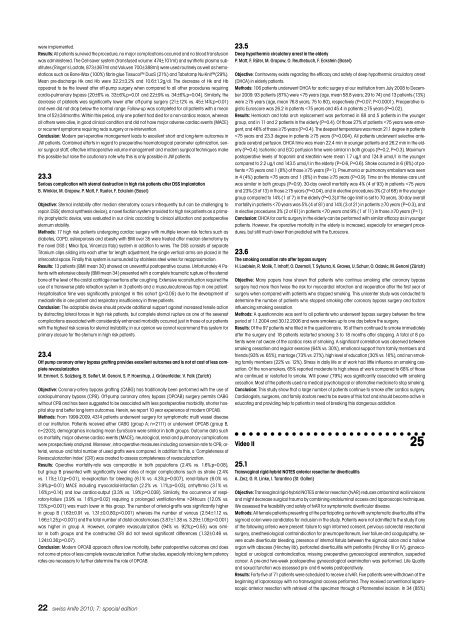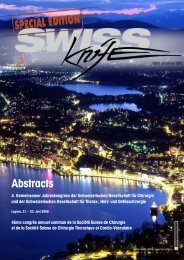Anorectal Manometry in 3D NEW! - Swiss-knife.org
Anorectal Manometry in 3D NEW! - Swiss-knife.org
Anorectal Manometry in 3D NEW! - Swiss-knife.org
Create successful ePaper yourself
Turn your PDF publications into a flip-book with our unique Google optimized e-Paper software.
were implemented.<br />
Results: All patients survived the procedure, no major complications occurred and no blood transfusion<br />
was adm<strong>in</strong>istered. The Cell-saver system (transfused volume: 474±101ml) and synthetic plasma substitutes<br />
(R<strong>in</strong>ger’s Lactate, 873±367ml and Voluven 700±388ml) were used rout<strong>in</strong>ely as well as hemostaticas<br />
such as Bone-Wax (100%) fibr<strong>in</strong>-glue Tissucol DuoS (21%) and Tabotamp Nu-Knit(29%).<br />
Mean pre-discharge Hk and Hb were 32.2±3.2% and 10.6±1.2g/dl. The decrease of Hk and Hb<br />
appeared to be the lowest after off-pump surgery when compared to all other procedures requir<strong>in</strong>g<br />
cardio-pulmonary bypass (20±6% vs. 33±6%;p=0.01 and 22±9% vs. 34±6%;p=0.04). Similarly, the<br />
decrease of platelets was significantly lower after off-pump surgery (21±12% vs. 45±14%;p=0.01)<br />
and even did not drop below the normal range. Follow-up was completed for all patients with a mean<br />
time of 52±34months. With<strong>in</strong> this period, only one patient had died for a non-cardiac reason, whereas<br />
all others were alive, <strong>in</strong> good cl<strong>in</strong>ical condition and did not have major adverse cardiac events (MACE)<br />
or recurrent symptoms requir<strong>in</strong>g redo surgery or re-<strong>in</strong>tervention.<br />
Conclusion: Modern peri-operative management leads to excellent short and long-term outcomes <strong>in</strong><br />
JW patients. Comb<strong>in</strong>ed efforts <strong>in</strong> regard to preoperative haematological parameter optimization, senior<br />
surgical staff, effective <strong>in</strong>traoperative volume-management and modern surgical techniques make<br />
this possible but raise the cautionary note why this is only possible <strong>in</strong> JW patients.<br />
23.3<br />
Serious complication with sternal destruction <strong>in</strong> high risk patients after DSS implantation<br />
B. W<strong>in</strong>kler, M. Grapow, P. Matt, F. Rueter, F. Eckste<strong>in</strong> (Basel)<br />
Objective: Sternal <strong>in</strong>stability after median sternotomy occurs <strong>in</strong>frequently but can be challeng<strong>in</strong>g to<br />
repair. DSS( sternal synthesis device), a novel fixation system provided for high risk patients as a primarily<br />
prophylactic device, was evaluated <strong>in</strong> our cl<strong>in</strong>ic accord<strong>in</strong>g to cl<strong>in</strong>ical utilization and postoperative<br />
sternum stability.<br />
Methods: 17 high risk patients undergo<strong>in</strong>g cardiac surgery with multiple known risk factors such as<br />
diabetes, COPD, osteoporosis and obesity with BMI over 35 were treated after median sternotomy by<br />
the novel DSS ( Mikai Spa, V<strong>in</strong>cenza Italy) system <strong>in</strong> addition to wires. The DSS consists of separate<br />
Titanium clips slid<strong>in</strong>g <strong>in</strong>to each other for length adjustment, the s<strong>in</strong>gle vertical arms are placed <strong>in</strong> the<br />
<strong>in</strong>tercostal space. F<strong>in</strong>ally this system is surrounded by sta<strong>in</strong>less steel wires for reapproximation.<br />
Results: 13 patients (BMI mean 30) showed an uneventful postoperative course. Unfortunately 4 Patients<br />
with extensive obesity (BMI mean 34) presented with a complete traumatic rupture of the sternal<br />
bone at the level of the costal cartilage <strong>in</strong>sertions after cough<strong>in</strong>g. Extensive reconstruction required the<br />
use of a transverse plate refixation system <strong>in</strong> 3 patients and a musculocutaneous flap <strong>in</strong> one patient.<br />
Hospitalisation time was significantly prolonged <strong>in</strong> this cohort (p24hours (12.0% vs.<br />
7.5%;p
















